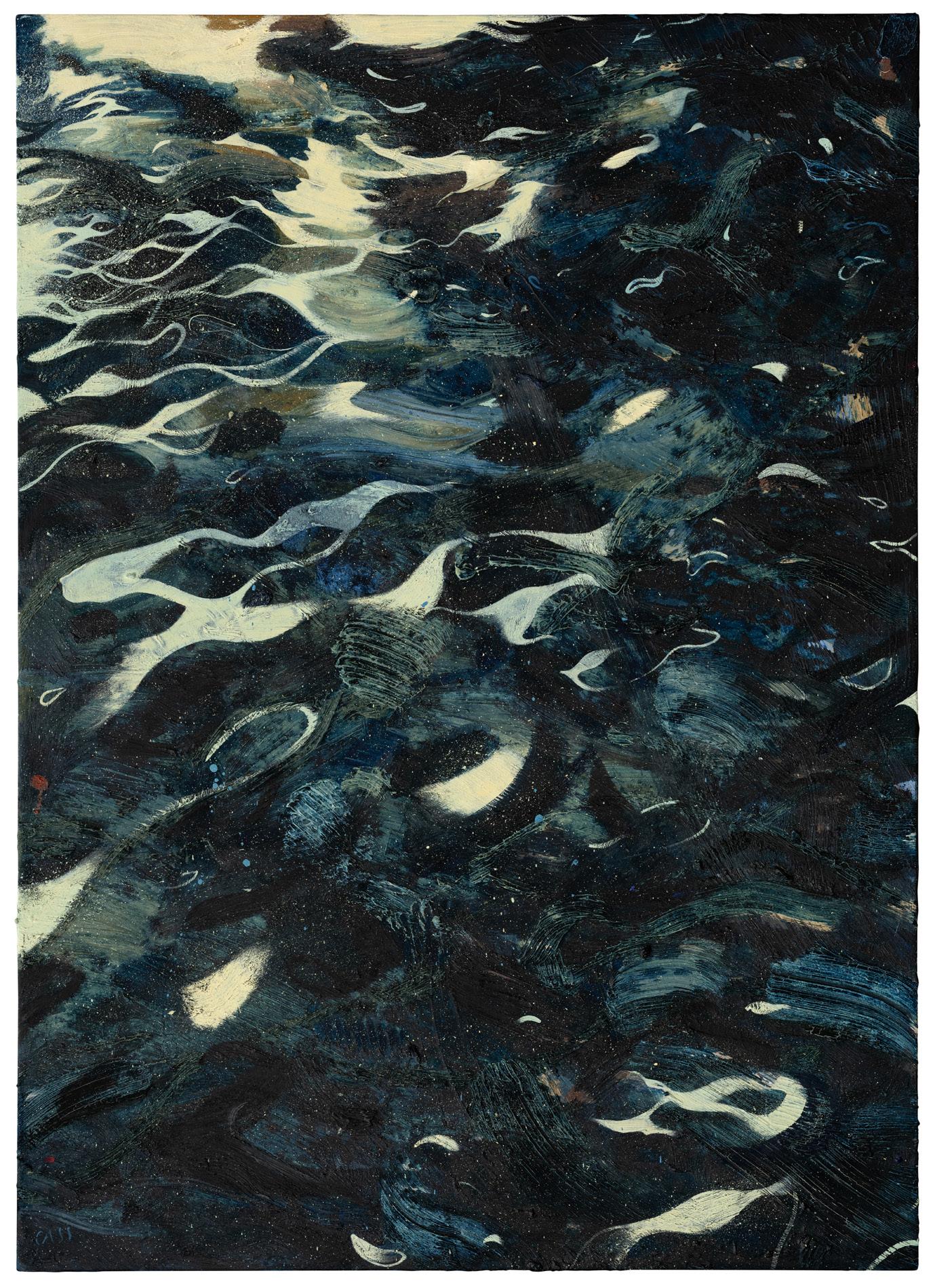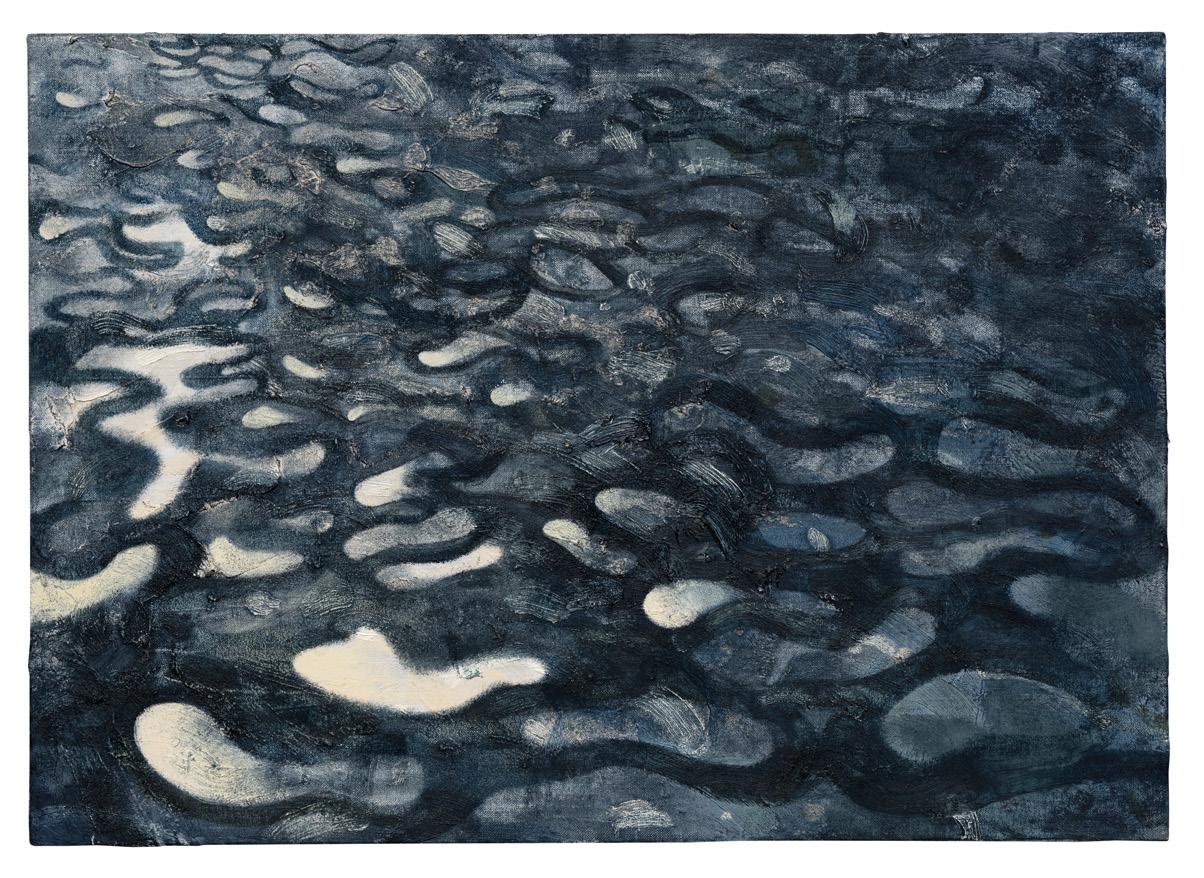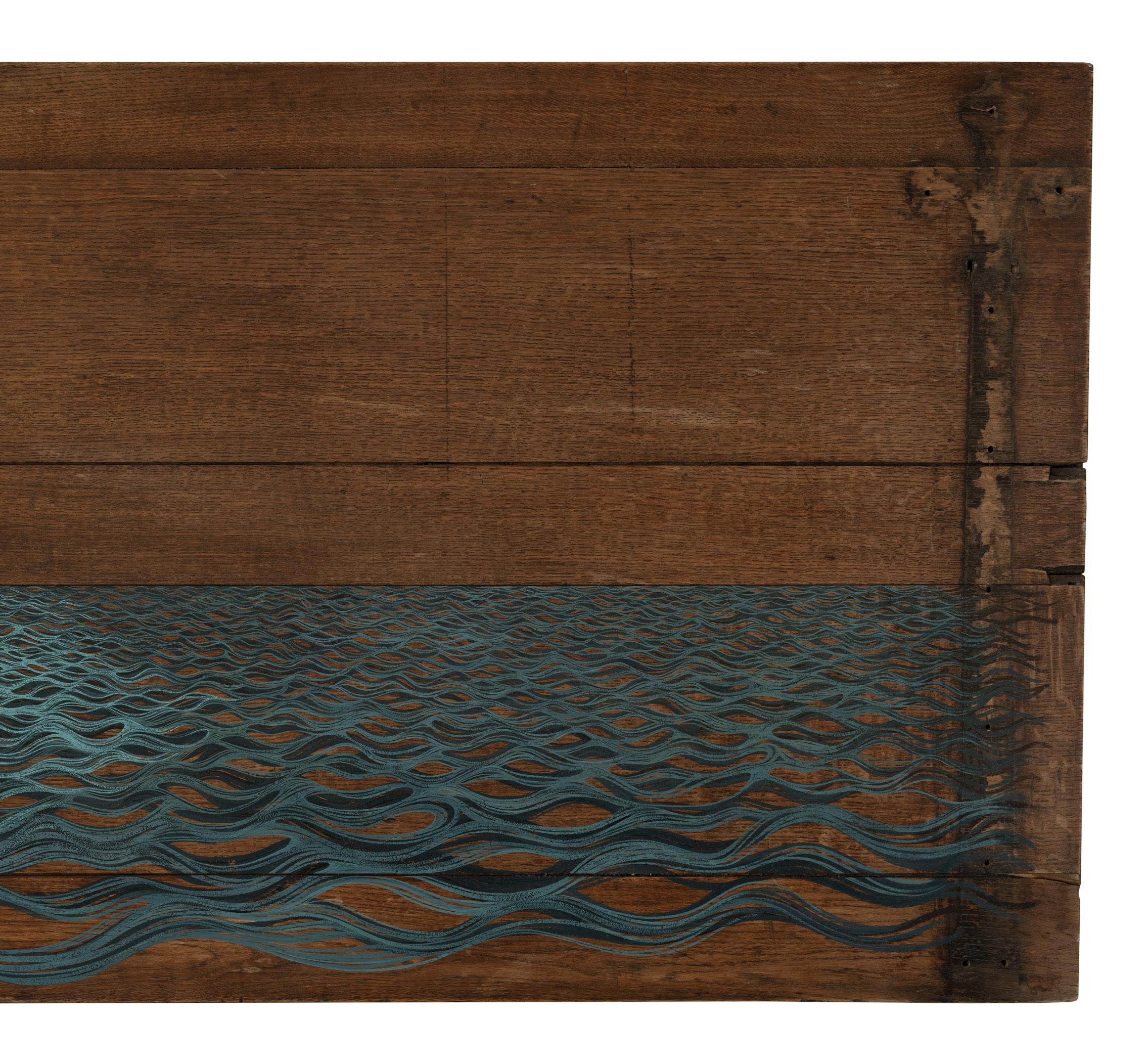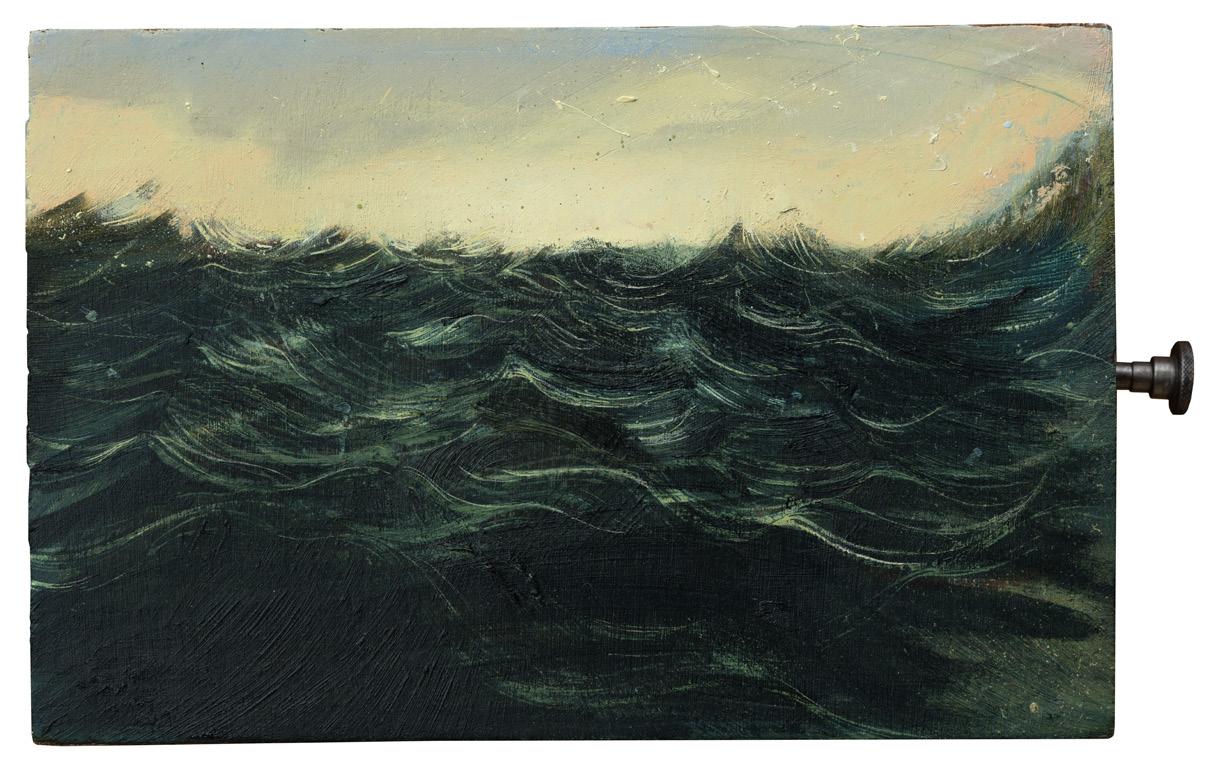








August 29th — September 28th 2024

The sea has captivated artists since time immemorial. For David Cass, born in Edinburgh (1988) and raised in the Scottish Borders, near the high moorland of the Lammermuirs, an interest in the natural rhythm of the local landscape led him to the sea as an early source of inspiration. Like Wilhelmina Barns-Graham, Cass was initially drawn to the sea to chart the patterns of wind and waves on the water’s surface. However, unlike Barns-Graham, whose studies were local in their focus, Cass’ seascapes are universal, depicting rhythmic expanses of open ocean rendered into images both beautiful and immutable.
In his latest exhibition, which marks the tenth major solo presentation of his career, the artist continues to use his art to campaign for climate awareness. Cass’ work becomes ever more prescient as society acknowledges the impact of climate change on our waters; the urgency of rising sea levels.
Cass paints the sea in all its moods, creating images that combine direct observation with a poetic sensibility. His painting sparkles in the light of the Aegean sun or simmers under the threatening glow of a North Sea flare stack. The scale of his work offers a range of vantage points, from aerial views reminiscent of ISS imagery to tiny, precious pools of light, like sea water cupped in one’s hands. The materials Cass chooses to paint on dictate the direction of the artwork. Working on found and antique surfaces, the grain of wood or the historic purpose of the material can influence the composition’s
design. These found items are reborn and repurposed in his studio. Worn through decades of use or neglect, the containers, drawers or pulleys (their places of origin included in each caption) are relics of a bygone era, representing a connection to the past, reminding us of a time when human impact on nature was less severe. Each serves as a poignant commentary on the intertwined fates of nature and human history.
Rising sea levels, unpredictable severe storms, and the bleaching of coral reefs starkly remind us of how human activity is altering the natural balance of our seas. For his tenth solo exhibition, Cass celebrates the power and majesty of the ocean, blending its beauty and strength to comment on the precariousness of our planet’s future.
Tommy Zyw
The Scottish Gallery



opposite left | cat. 2
ACCOUNT
(Brussels) 2023—24
oil on bus blind on board
60 x 40 cm
opposite right | cat. 3
CONSIDER
(London) 2024 watercolour & oil on card / box
21 x 13.5 cm
above | cat. 4
CONGRESS
(Brussels) 2022—24
oil, oil bar, spray paint & pastel on bus blind on board
32 x 68.5 cm



opposite | cat. 5
COMMIT
(Brussels) 2022—23
oil on bus blind on board
75 x 80 cm
cat. 6 MEND
(Brussels) 2024 oil on bus blind & antique canvas on board
43 x 38.5 cm
cat. 7
MEASURE
(London) 2024 oil on plastered beer mats on board
50 x 46 cm

IDENTIFY (Brussels) 2022—23
oil, oil bar, spray paint & pastel on bus blind on board 120 x 80 cm
opposite left | cat. 9 TRACE (Athens) 2023 oil on nautical map on board
72.5 x 31.5 cm
opposite right | cat. 10
REFLECT (Edinburgh) 2023—24 oil & pastel on salvaged canvas on board



Sunlight spills across the sea’s surface. Moving water makes it dance. Billions of tiny highlights blink then falter before collapsing into waves. The picture changes by the millisecond.
Despite painting sea for the better part of fifteen years, I had never lived in sight of the sea until moving to Athens, Greece, in 2021. Before drawing work to a close in my Scottish Borders studio, the workspace I created the majority of this exhibition in looked out over a great panorama: Piraeus port to the north, Vouliagmeni to the south, and the islet of Ydroussa in between (colloquially known as “black island,” for the numerous times, decades ago, when it was covered by oil from run
aground tankers on their approach to the nearby port). I learned that it could be raining hard over Piraeus as bright sunlight illuminated the Vouliagmeni peninsula; that the sea’s surface acts as a screen for shadow-play in winter but can be too bright to face in summer. From this temporary studio, I had expected to paint islands and coastlines, but instead found myself captivated by endless ever-changing light on water.
But a threat rests behind this mesmeric picture. In this exhibition, light also represents heat. Our oceans are storing an estimated 91 percent of the excess heat energy trapped in the Earth’s climate system.



As warming climbs exponentially, our planet’s oceans – also home to most of its life – won’t be able to store any more of it. Every other breath we take comes from microscopic underwater organisms. That same water is absorbing nine times as much global warming as the world above the surface. On the week of publication in late July 2024, the hottest day in modern history was recorded.


(Brussels) 2023
oil on bus blind on board
31 x 43.5 cm
(Brussels) 2023—24 oil, oil bar & pastel on plastered bus blind on board
34.5 x 40 cm


cat. 17
RECOUNT
(Brussels) 2022—23 oil, oil bar, spray paint & pastel on bus blind on board
130 x 80 cm (detail)



PRIORITISE
(Brussels) 2024
oil on bus blind on board
24.5 x 36 cm
PRESERVE
(London) 2023
oil on salvaged canvases on board
58 x 41.5 cm






OBSERVE
(Athens) 2024
oil on board
128.5 x 97.5 cm (detail)
(Brussels) 2024
oil on bus blind on board
60 x 40 cm


I started work on the main body of this exhibition in the summer of 2022, after having spent the three previous years working almost exclusively on a small scale. In these latest works, I’ve gradually applied expressive layers of oil in abstract shapes onto vintage industrial canvases and large format nautical maps pasted to board. Like the telling and re-telling of a story, I’ve traced and re-traced loops and curves, following familiar channels to build thick swells of paint. Many of these paintings see my mark-making style inverted, with more emphasis placed on the negative space.

Light on Water leads on directly from my previous solo exhibition at The Gallery in 2019, Rising Horizon. That exhibition charted an ever-increasing horizon-line, from the bottom to the top of the canvas, providing commentary on the issue of sea level rise – one consequence of global heating. Painted onto a range of found objects, including some of a more industrial nature, each painting in Rising Horizon acted as a springboard for a wider discussion. The series opened with big skies and closed with paintings of mostly sea surface, their horizons well over head height. This exhibition continues the theme, with the main body of abstract paintings fully covered and without sky, many based on close-up wave formations. Just like Rising Horizon, there is a progressive quality to this new series, an exploration of proportionality. The paintings range from mostly dark in colour to mostly light. In some cases, the light represents sunlight, in other cases it could be sea ice, battling against the dark water beneath.
Other paintings look back to a time before global warming – before the Industrial Revolution – making subtle nods to the works of Old Masters (see p.50—57). In all, ten groupings make this show, mostly categorised by materials, each ranging in pace and tone. As ever, I’ve worked with recycled objects wherever possible, found at flea-markets and antique shops on my annual gathering expeditions. Light on Water features artworks made using pulleys, stamps, doors, tins, codfish boxes, matchboxes, cards, various types of board and canvas (including maps and bus blinds). The act of gathering is an important part of my artistic practice, perhaps as important as that of applying paint. The right surfaces must be found: functional and familiar, with a solid ground to work upon; yet unique enough to spark interest (in myself, and my audience). In this catalogue, the place each object was found has been added to the accompanying caption. These are places that I’ve lived or visited at regular intervals.

cat. 27
(Brussels) 2023—24 oil, oil bar & pastel on plastered bus blinds on board 35 x 37 cm

In recent years, I’ve tried not to paint specific places. I prefer my seascapes (or, abstract works reminiscent of seascapes) to represent any and all oceans. But there are references to Greece: scenes painted onto six codfish boxes (found during my time in the USA) are based on the islet of Ydroussa, seen from my temporary workspace. And the inspiration for some of the more deeply textured works comes from island and coastal architecture, from decaying fibreglass boats (a big issue here), salted peeling walls and patchwork dockside doors. In an effort to cool homes before the advent of air conditioning, the walls of some island homes were heavily textured with plaster and spatula, so that even during the brightest of days small pockets of shade helped cool the stone. I too used plaster and spatula in some of these works, carving out waves; applying oil bar and layers of oil paint to form channels so that changing light throughout the day interacts with the paintings.
Halfway through producing this exhibition I co-curated Points of Return, a 27-artist multimedia show in Massachusetts, USA. Our aim was to present an exhibition which offered strategies and reasons for optimism in the face of climate crisis. Light on Water aims quietly to do something similar: through use of recycled materials and patient dedication to its thirty main paintings, each worked on (simultaneously) for many months.
Suggestive of sustainable practices, their titles are an appeal to slow and to reflect.

If we look to the North and South Poles –Earth’s thermostats – the consequences of warming water are disastrous. Here, we are faced with one of the most striking visuals of the climate crisis: a battle of light vs. dark. As we lose ice, we also lose its ability to reflect sunlight. Less white reflective ice at our Poles means more dark heat-storing sea; more heated sea means more melting ice. In a warming planet, ice can’t re-form. It’s the ice that provides the Earth’s climate with the balance that we need.

28
REDUCE
(Fife) 2023—24
oil, solar reflective white paint, spray paint & ink on wooden box lid
31.5 x 88 cm
overleaf | cat. 29—44
LIGHT on WATER SKETCHES
(various locations) 2023—24
pencil, egg tempera, watercolour & gouache on cards various dimensions






(various locations, UK) 2023 gouache on wooden offcuts within Scottish Bluebell matchboxes each 3.5 x 10 x 2 cm approx.


56—61
(various locations, USA) 2023—24 oil on primed codfish boxes each 15 x 10 x 5 cm approx.

cat. 62—67
(various locations, UK & Europe) 2023—24 oil on plastered decorator’s stamps & wooden corbels various dimensions

left | cat. 68
PULLEY I
(Rockport, ME) 2023—24
oil on marine pulley
23 x 11.5 x 8 cm
middle | cat. 69
II
(Freeport, MA) 2023—24
oil on marine pulley
20 x 6 x 4 cm
right | cat. 70
III
(Norway, ME) 2023—24
oil on miniature pulley
10 x 2.5 x 1.5 cm



left | cat. 71
PULLEY IV
(Camden, ME) 2023—24
oil on marine pulley
18 x 8 x 6 cm
middle | cat. 72
PULLEY V
(Chatham, MA) 2023—24
oil on marine pulley
12.5 x 7 x 4.5 cm
right | cat. 73
VI
(Boston, MA) 2023—24
oil on marine pulley
23 x 11.5 x 9 cm



left | cat. 74
PULLEY VII
(Wiscasset, ME) 2023—24
oil on marine pulley
35 x 11 x 7 cm
middle | cat. 75
PULLEY VIII
(Lincolnville, ME) 2023—24
oil on marine pulley
30 x 13 x 10 cm
right | cat. 76
PULLEY IX
(Rockland, ME) 2023—24
oil on marine pulley
15 x 6 x 4 cm



The starting point for this smaller and more representational series was studying the works of Old Masters for an exhibition and performance at Christie’s (London) in late 2023. While most of these pieces channel the essence of those often romanticised and dramatic scenes, there are two pieces which directly respond to specific paintings by Julius Porcellis and Andries van Eertvelt.
cat. 77
YEARS II or 500 YEARS AFTER VAN EERTVELT
(Paris) 2023—24
oil & pencil on gessoed artist’s box insert
16 x 29 x 2 cm


YEARS I or 500 YEARS AFTER PORCELLIS
(London) 2023
oil on gessoed chest panel
23 x 37 x 3 cm
The painting opposite is accompanied by a performance, which you can view by scanning the QR code below. The painting and performance both come together to visualise Porcellis’ c.1630 seascape Ships in Distress off a Rocky Coast five centuries after its creation, in a world where climate breakdown has heightened the severity of storm surges and radically altered our oceans.


V
(Waltham, MA) 2024
oil & pencil on gessoed drawer base
15 x 22.5 x 6 cm
YEARS VII
(Edinburgh) 2024
oil & pencil on gessoed chest panel
22 x 29 x 1.5 cm


cat. 81
YEARS VI (Edinburgh) 2024 oil on gessoed wooden box
18 x 35.5 x 8 cm



Over the last few years, I’ve been collecting old photographs, slides, postcards and news cuttings featuring (long lost) ice – bergs, sheets, floes, glaciers, snow – to form an archive of sorts. Certainly, the ice featured in most of these images is now melted. There’s a deep sadness to the loss of these mammoth bergs, once seen as a “menace” (as more than one news clipping states) they are today indicators of our planet’s health. Ice loss from Greenland and Antarctica has increased fivefold since the 1990s, and now accounts for a quarter of sealevel rise. The Greenland ice cap alone is losing an average of 30m tonnes of ice an hour (Nature, vol. 625, 2024); calving ice making way for dark heatstoring sea.




Since graduating from Edinburgh College of Art in 2010, I’ve presented ten interconnected physical solo exhibitions, plus the solo virtual exhibition Journey of an Artwork and several online fundraising endeavours (for The Marine Conservation Society, charity:water and The Disasters Emergency Committee). Between each, I’ve organised and participated in numerous mixed and open shows, award exhibitions, collaborative projects and outreach events – including workshops, screenings and recently a performance –with a mounting environmental agenda. I’ve contributed to displays at COP21, 26 & 27; and exhibited at venues including Christie’s, The Royal Academy, Royal Scottish Academy and The Scottish Gallery.
September 2011: UNEARTHED
In this first exhibition at The Scottish Gallery, a collection of found object based watercolour paintings introduced my working approach.
June 2013: YEARS OF DUST & DRY
A second exhibition at The Gallery saw this approach intensified, with a deeper focus on the sea and bodies of water, and over 200 paintings and constructions made using increasingly unconventional recycled materials.
July 2015:
As a result of a Royal Scottish Academy scholarship, an interest in travel and historic environmental events was ignited, leading to a body of artworks exhibited at The Gallery on recycled papers depicting, among other subjects, scenes of historic Great Floods in Florence & Paris and drought in southern Spain.
April – May 2016:
SURFACE | Part I of II
As my preoccupation with water took on a more prominent role in my practice, this pop-up solo at Gayfield Creative provided a comprehensive look back at water paintings – on a variety of surfaces – created between 2010 and 2016.
November 2016:
PERIMETRI PERDUTI (PERIMETERS LOST) | Part I of II
This exhibition and book launch in Florence’s Palazzo Lanfredini –headquarters of The British Institute of Florence – marked the 50th year since the city’s Great Flood of 1966. I designed a book describing the events surrounding the catastrophic inundation, drawing parallels with contemporary environmental extremes. The launch event featured eyewitness accounts from those who lived through the flood and was followed by the Italian première of Roger Graef’s Why Save Florence
January 2017: PEŁÀDA
To open The Scottish Gallery’s 175th anniversary celebrations, I was selected to exhibit as an ambassador of the gallery’s contemporary tier. Here, my focus shifted from Florence to Venice, and from the theme of historical inundation to present-day issues of mass tourism and rising sea levels.
January – February 2019: RISING HORIZON
A fifth solo exhibition with The Gallery zoomed out: from detailed depictions of Venice’s plight to a more general look at the global issue of rising sea levels. Here, a climbing horizon-line was used as a tool to impart climate data; further explained in the accompanying publication and an in-conversation event with climate change scientist Dr Dave Reay. This exhibition featured new working materials including recycled (re-formed) plastic waste and metals.
January – February 2020
As Scotland’s Year of Coasts & Waters began, Taigh Chearsabhagh Museum & Arts Centre in North Uist presented a second instalment of my sea rise series alongside workshops and talks. New additions to the series referenced the gallery’s location, at the very edge of a low-lying island, as sea levels gradually climb.
April – May 2022:
WHERE ONCE THE WATERS | Venice Biennale 2022
The COVID-19 pandemic hit soon after Horizon Rising, resulting in the delay of my 2021 Biennale exhibition. The extra year allowed for the expansion of my original idea and increased online activity during the period led to a more interactive project. Participants from around the world took part in my sea level survey, resulting in hundreds of personalised typed letter-artworks. These were combined with a series of 365 miniature seascapes painted onto vintage metal tins, symbolising record breaking annual ocean temperatures. Various iterations of the two-part project have since been exhibited, with groupings of the works exhibited in the UK, USA & Egypt. One hundred of the miniature seascapes were shown during The Gallery’s exhibition Contemporary, and fifty can be found in Light on Water. You can take part in the ongoing sea level survey by visiting: www.davidcass.art/whereonce.
August – September 2024: LIGHT ON
The title of my tenth solo exhibition – a sixth with The Gallery –possesses a dual meaning. While the show overall acts as a survey of key themes and materials, a main body of paintings was created using a new approach. Built from many layers, these cropped closeups at once celebrate the sea’s brilliance, abstractly describing the play of light across its surface; whilst also referencing the very real issue of warming seawater, including in our Earth’s most vulnerable regions.

Published by The Scottish Gallery to coincide with the exhibition:
August 29th — September 28th 2024
Full exhibition can be viewed online at: www.scottish-gallery.co.uk/davidcass
ISBN: 978-1-912900-88-6
Design by David Cass + The Scottish Gallery Printed by PurePrint Group using sustainable stock Fonts by Mint Type, Ukraine
All rights reserved. No part of this catalogue may be reproduced in any form by print, photocopy or by any other means, without the permission of the copyright holders and of the publishers.
cat. 84 FLASK (Athens) 2024 oil on rare wooden teardrop canteen
32 x 14 x 10 cm approx.



